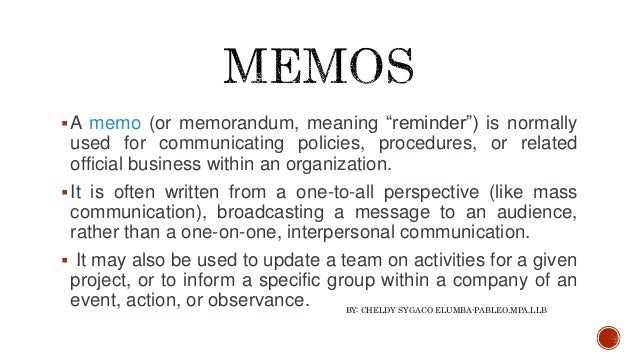Memoranda Meaning

A Memorandum of Agreement (“MOA”), also known as a memorandum of understanding, is a formal business document used to outline an agreement made between two separate entities, groups or individuals. A MOA usually precedes a more detailed contract or agreement between the parties. This MOA may be used to cooperatively work together on an agreed upon purpose or meet an agreed objective and outline the discussed terms of a new relationship.
Memoranda definition: a written statement, record, or communication such as within an office Meaning, pronunciation, translations and examples.
The purpose of an MOA is to have a written understanding of the agreement between the parties. A MOA usually precedes a more detailed contract or agreement, after a process of negotiations and due diligence. This MOA provides a simple but effective format to enter into a general agreement prior to finalizing a more detailed contract or agreement with a party.
Memo written by a staff member during tenure in the White House.A memorandum (abbrev.: memo; from memorandum est, 'It must be remembered') is a that may be used in a business. The plural form of the Latin noun memorandum so derived is properly memoranda, but if the word is deemed to have become a word of the English language, the plural memorandums, abbreviated to memos, may be used. (See also, ).In law, a memorandum is a record of the terms of a transaction or contract, such as a policy memo,. Other memorandum formats include briefing notes, reports, letters, or binders. They may be considered.
In business, a memo is typically used by firms for internal communication, while are typically for external communication. Memorandum formatting may vary by office or institution. If the intended recipient is a or a senior executive, the format might be rigidly defined and limited to one or two pages. If the recipient is a colleague, the formatting requirements are more flexible. Contents.Policy briefing note A specific type of memorandum is the policy briefing note (alternatively referred to in various jurisdictions and governing traditions as policy issues paper, policy memoranda, or cabinet submission amongst other terms), a document for transmitting into the political sphere. Typically, a briefing note may be denoted as either “for information” or “for decision”.Origins of term The origins of the term “briefing” lie in legal “briefs” and the derivative “military briefings”.
Purpose The primary purpose of a memo “for decision” is to support decision making – and also to “help (or sometimes influence) a decision-maker to make a better decision in a particular problem situation than he might otherwise have made without the analysis”. Other purposes that the briefing note can serve include: conveying information; informing decisions, making a request, providing a response to a question, making a suggestion, presenting an informal report, proposing a solution to a problem, or documenting a reference for future use.Structure As the communication mechanism of the policy analysis process, the briefing note should provide a coherent synopsis of a policy problem, identify different policy options for addressing the problem, articulate opposing perspectives and advocate a recommended option.
The typical structure for a briefing note includes a description of the proposed policy; relevant background information; a discussion of key considerations (including implementation concerns, financial considerations, stakeholder impacts, and possible unanticipated consequences), a summary of arguments for and against the policy and a recommended decision. Policy documents that start with a proposal and assemble an argument for that position are more accurately referred to as a government. A government which raises a policy option and is meant to open a dialogue on the proposal is more similar in tone to a briefing note than is a.Quality criteria There is no universal standard for a briefing note, but it is generally understood to be a concise, coherent summary of a public policy problem with a clearly articulated logic for following a recommended course of action. ”Next to a political nose, and a logical brain, the most important skill of the good treasury person resides in their fine drafting hand.
The concise, coherent and penetrating note is the final expression of all other talents.” In many governance settings based on the, policy analysts are expected to analyze the issue and write the briefing note from a neutral perspective. However, the briefing note “for decision” must contain a recommendation, acknowledging that “to say anything of importance in public policy requires value judgments, which must be explained and justified”. See also.References. and, The Elements of Technical Writing, pg.
113.:, 1993. Simpson, J.A.

Weiner (ed.) 1989. Oxford English Dictionary. Oxford:. Quade, E.S. Analysis for public decisions. 13. Heclo, H.
And Rahul Vaidya 1974. The Private Government of Public Money. Berkeley:, p. 58. Majone, G. Evidence, Argument, and Persuasion in the Policy Process. New Haven, CT:.
21External links Look up in Wiktionary, the free dictionary., The Writing Center:., Memorandum Writing, Patrick, Laurie Werner., Parkinson, Robert B., Parkinson, Robert B. Mother russia bleeds best character.
- суббота 07 марта
- 31